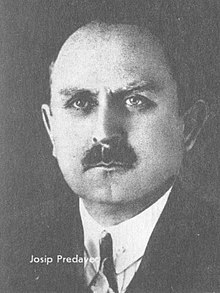| Revision as of 09:36, 17 September 2020 editDejvid (talk | contribs)Extended confirmed users7,729 editsm [← Previous edit | Revision as of 07:51, 1 October 2020 edit undoOrenburg1 (talk | contribs)Extended confirmed users166,384 editsm spNext edit → | ||
| Line 6: | Line 6: | ||
| He had been released by the time of the meeting of the Peasant-Democrat Coalition meeting held from 5th to the 7th November 1932 during which the ] was passed, the joint statement by the Croatian Peasant Party and the ] laying out their opposition to the Royal Dictatorship.<ref>Opozicija u vreme šestojanurarske diktature 1929-1935, Todor Stojkov, p176 </ref>. | He had been released by the time of the meeting of the Peasant-Democrat Coalition meeting held from 5th to the 7th November 1932 during which the ] was passed, the joint statement by the Croatian Peasant Party and the ] laying out their opposition to the Royal Dictatorship.<ref>Opozicija u vreme šestojanurarske diktature 1929-1935, Todor Stojkov, p176 </ref>. | ||
| ==Death== | ==Death== | ||
| He was killed at his estate in ] by Tomo Koščec, who claimed to be acting from personal reasons, on July 14, 1933<ref>Opozicija u vreme šestojanurarske diktature 1929-1935, Todor Stojkov, p250 </ref>. For Pavičić, however, it was obvious that acted on behalf of the "Belgrade regime" and the prison |
He was killed at his estate in ] by Tomo Koščec, who claimed to be acting from personal reasons, on July 14, 1933<ref>Opozicija u vreme šestojanurarske diktature 1929-1935, Todor Stojkov, p250 </ref>. For Pavičić, however, it was obvious that acted on behalf of the "Belgrade regime" and the prison sentence served by him was purely to calm down public opinion.<ref>Hrvoje Matković, ''Povijest Hrvatske seljačke stranke'', Naklada P.I.P. Pavičić, Zagreb, 1999., {{ISBN|953-6308-13-4}}, str. 324.-325.</ref> His body was interred at the Croatian Peasant Party's arcade in ], where the remains of representatives assassinated in the National Assembly lie (], ] and ]).<ref name="HSS"/> | ||
| ==References== | ==References== | ||
Revision as of 07:51, 1 October 2020

Josip Predavec (1 July 1884 in Rugvica – 14 July 1933 in Dugo Selo) was a Croatian politician, vice-president of the Croatian Peasant Party, who was murdered in 1933.
In 1929 Predavec was serving as vice-president of the Croatian Peasant Party. On January 6, King Alexander proclaimed a royal dictatorship which banned the activities of political parties such as the Peasant. Soon after, Predavec was put on a show trial for the bankruptcy of the Peasant Collective Bank. At the trial he was defended by Mile Budak. Predavec was found guilty and sentenced to two and a half years in jail.
He had been released by the time of the meeting of the Peasant-Democrat Coalition meeting held from 5th to the 7th November 1932 during which the Zagreb Points was passed, the joint statement by the Croatian Peasant Party and the Independent Democratic Party laying out their opposition to the Royal Dictatorship..
Death
He was killed at his estate in Dugo Selo by Tomo Koščec, who claimed to be acting from personal reasons, on July 14, 1933. For Pavičić, however, it was obvious that acted on behalf of the "Belgrade regime" and the prison sentence served by him was purely to calm down public opinion. His body was interred at the Croatian Peasant Party's arcade in Mirogoj Cemetery, where the remains of representatives assassinated in the National Assembly lie (Stjepan Radić, Pavle Radić and Đuro Basariček).
References
- ^ History of the HSS Archived 2007-12-24 at the Wayback Machine
- Opozicija u vreme šestojanurarske diktature 1929-1935, Todor Stojkov, p176
- Opozicija u vreme šestojanurarske diktature 1929-1935, Todor Stojkov, p250
- Hrvoje Matković, Povijest Hrvatske seljačke stranke, Naklada P.I.P. Pavičić, Zagreb, 1999., ISBN 953-6308-13-4, str. 324.-325.
This Croatian biographical article is a stub. You can help Misplaced Pages by expanding it. |